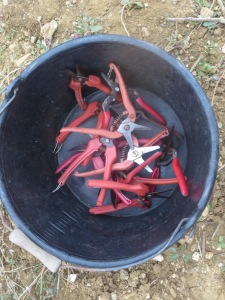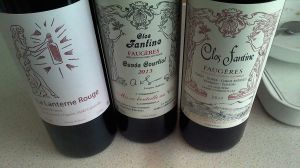
Let’s start with the Jeff Coutelou wines first. 5SO Simple 2018 has really found its feet now, which is probably too late for the vast majority of bottles opened as it is usually a wine opened for early drinking as a ‘glou glou’. Cinsault is light, the grapes tend to be large and juicy and not have too much acidity. Jeff likes acidity in his wines to help maintain their condition and health, without SO2 as a preservative the acidity can be a useful substitute as well as adding freshness to the wine. The acidity of this 18 bottle was calmed and the fruit was showing more roundness than the last bottle I had. It’s in a very good place, very enjoyable.
I opened two bottles of La Vigne Haute, my favourite wine. A 2013 was in excellent shape, the Syrah black fruit and spice still prominent, the tannins soft and the age was adding another layer of complexity and depth. No rush to drink up but definitely ready. However, the 2017 was on another level. I opened it on my birthday and it was a highlight of the month. It is ready to drink now and very enjoyable too but I’ll hang on to my other bottles a little while. The acidity is fresh but well balanced, the fruit is open and mouth filing. It has a youthful energy but it’s also round and enjoyable from the outset. On this evidence La Vigne Haute 2017 has the potential to be one of the best vintages of this great wine.
Amicis is the wine I made at Jeff’s in 2015 with grapes from Rome vineyard, the three types of Grenache. Aged in three different containers (old barrel, newer barrel and glass). You can read more here. I opened a bottle of the older barrel aged wine meaning the staves were tighter and so there was less exchange with air, the wine is more youthful than the wine in the newer barrel. Cherry red, fresh acidity and the residual sugar giving a sweetness. It is more an aperitif wine than a food wine and it will age for years.
Let’s stay in the Languedoc and near neighbours and friends the Andrieu family of Clos Fantine. Their vineyards are high in the Faugères hills and the vines are gobelet to give them a freedom and energy, described by Corine here. The Fantine reds need time, they have concentrated fruit and tannin which take time to marry and mature. Give them that time and the rewards are plentiful. This bottle of the traditional Faugères is non vintage. They had some Carignan from 2016 and 2017 which took their time to finish fermentation, they were a bit stuck. When they finally completed Corine added some Grenache and Syrah from 2017 and also some Cinsault and Mourvedre from 2019. The blending is therefore similar to what Jeff does with his L’Oublié bottle. The result was excellent, a full bodied, complex wine with a freshness from the 2019 wines. Power and elegance. I must order some more.
Still in the Faugères area and a young winemaking couple whom I first visited in the snow! Simon and Sara Bertschinger have a few hectares around Fos with unusual grape varieties for the region, the Armélot 2015 I opened contains Merlot and Petit Verdot, they also have some Sangiovese. Like the Fantine wine this is unmistakably Faugères, depth, power, freshness to the fore. The 5-6 years of age have brought a lovely maturity, another bottle at its peak. The Merlot adds a roundness to the wine, it is lovely.
Heading down towards Spain, Banyuls. I tasted La Cave des Nomades wines for the first time at La Remise in Arles in 2016 when Jose (Zé) Carvalho was the talk of the town. The wines were exciting and fresh with incredible depth. I haven’t had the chance to drink many since then and was pleased to find Camino Rojo 19 available. Grenache and Syrah (taken direct from pressing) produces a light coloured wine but it is packed with flavour, red fruits and cleansing acidity. More please.
Two examples of Gamay next, both French. I recall visiting and holidaying in the Forez region in central France many years ago and the local wines were a rarity and simply a quaffing wine in local restaurants. Some producers have worked hard to add quality to the region and the leading domaine is Verdier-Logel. They work organically and this Poycelan Cuvée des Gourmets 2019 is made from grapes grown on granite soils, they also have Gamay on volcanic soils. I enjoyed it, there is plenty of fruit though it was fuller and a little heavier than most Gamays. Interesting and good to try wines from less well known areas. More classic Gamay in the form of Beaujolais, indeed a Beaujolais Nouveau 2020. Guy Breton is one of the great producers of the region, I remember a P’tit Max I had in Paris a few years ago as one of the bottles which converted me to a love of natural wine. Cuvée Fanchon was lovely, round, soft red fruits – absolutely classic Beaujolais and Gamay – delicious.
My biggest surprise of the month though was a Malbec from Argentina, Familia Cecchin 2019 no added sulfites. Argentinian Malbec has become very popular in supermarkets with a range of big, powerful wines – I usually find them too big and heavy for my taste. This, though, was a really pleasant surprise. There is a lightness and freshness to the wine as well as plenty of big flavours. Very good winemaking, a real deftness. I decided to try wines from further afield this year and this bottle really supported that decision, a genuine treat.
Wines were purchased: direct from producer, Leon Solarski wines, Buon Vino wines, Petites Caves, Little Wine































































